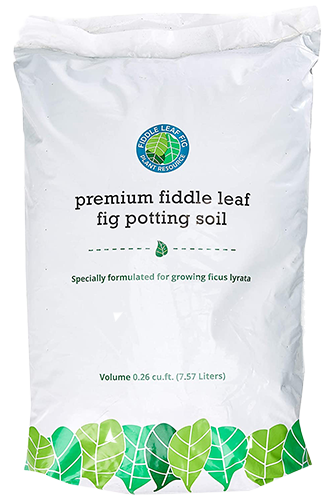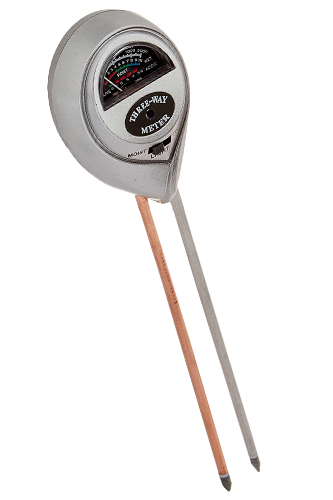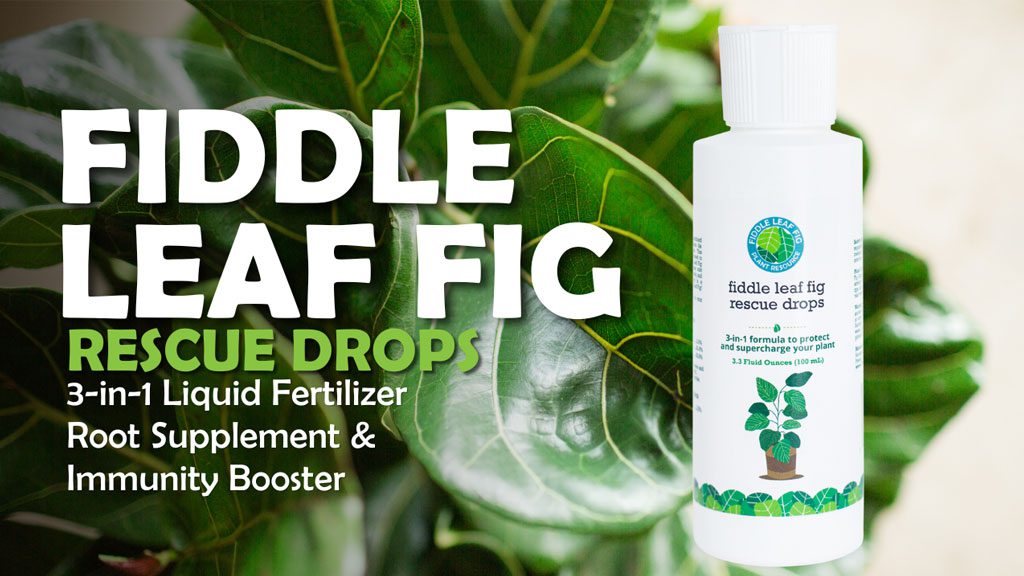Fiddle leaf figs are beautiful trees that can grow very large, very quickly. Indoors, these trees can reach 10 feet tall or even more with adequate light and space. However, if something is off with their environment or care, fiddles can lean or grow crookedly rather than growing straight up.
This can put stress on the trunk and cause breakage—as well as just looking weird.
This can easily be prevented with proper care. But sometimes that perfect care doesn’t happen and we have to correct issues with leaning or a weak trunk. (Like if we take in a rescue fiddle that didn’t get the right light, water, or nutrient conditions while it was growing.)
Even if our tree does start to lean a little, that doesn’t necessarily mean the tree can’t be healthy. Leaning can actually be an adaptation to an unideal environment, and can actually make the tree healthier! See leaning or reaching as a sign that you could be taking better care of your tree, and that your tree is doing its best to take care of itself and adapt to its surroundings.
Here are 4 reasons why fiddle leaf figs might lean and what you can do about it!
Reasons Your Fiddle Leaf Fig Is Leaning
There are four main reasons why fiddle leaf figs might lean rather than growing straight. Generally, this is due to improper watering, insufficient light, nutrient deficiency, or inadequate airflow.
These factors can potentially lead to a weak trunk that simply can’t support itself, or can cause the tree to grow lopsided as an environmental adaptation.
Here’s how to address each of these issues!
Ensure Watering Needs Are Met
Proper watering is basic fiddle leaf fig care 101, but it’s still one of the trickiest skills to master. But it’s an important one!
Underwatering can lead to a weak trunk that leans to one side, simply because it doesn’t have the strength to support itself. Without water, plants can’t function and transport nutrients from the roots to the trunk and leaves. Water is critical to every bodily process that keeps a plant alive, including growth and trunk formation. Don’t skimp!
On the other hand, overwatering your fiddle can damage roots and even cause them to rot, which may inhibit nutrient water and absorption. Naturally, this also leads to a weak, leaning trunk because your poor tree won’t have the resources to grow correctly.
It’s crucial to get the hang of properly watering your fiddle leaf fig to support the overall health of the plant and help it grow a strong, supportive trunk.
When to Water Your Fiddle Leaf Fig
Too many fiddle leaf fig owners get into trouble because they water on a schedule rather than taking cues from their plant.
Make sure to check to see if your plant is actually ready for a drink before you water it. You can do this in a few different ways: the finger test, the poke-a-stick test, or a moisture meter.
Generally, you want to water when the top 2-3 inches of soil are dry to the touch, or when a moisture meter reads 3-4. You can stick your finger in the soil to see if the top layer is dry, or you can poke a chopstick or other wooden stick into the pot to check the moisture level.
For a plant that gets plenty of light and is planted in soil that drains well, you should be watering every 7-14 days. Keep in mind that your fiddle leaf fig’s needs might vary depending on the time of year, light conditions, temperature, and humidity levels. This is another reason why it’s so important to keep tabs on your soil’s moisture level rather than blindly watering on a schedule!
Plant in Well-Draining Soil
It’s also important that you plant your fiddle leaf fig in a potting mix that drains well because this will either make or break your watering efforts.
If your soil is too heavy and retains too much moisture, your roots will be sitting in water for way too long and can start to rot, which can lead to a leaning tree and a host of other health problems.
(And we don’t need to say it, but your pot has drainage holes, right? After all, the best soil in the world won’t do much good if your pot doesn’t drain well!)
It’s also important to keep your soil well aerated rather than letting it harden and compact in the pot. Compacted soil doesn’t absorb or release water readily, so you can end up with symptoms of both over- and underwatering. Not good!
Using a Moisture Meter
We recommend using a moisture meter because it gives you a more accurate idea of what’s going on deeper in the pot. After all, if your soil isn’t well aerated, it’s absolutely possible for the top layer to be dried out while the root ball is still wet!
This is the moisture meter we like because it also measures light and humidity. Give it a try!
To use a moisture meter, insert the sensor into the soil about halfway between the bottom of the plant and the side of the pot, and push it about halfway down. Take your reading, and then remove the meter, clean the sensor, and keep it in a safe place. Don’t leave the meter in the soil, because this can damage the sensor and lead to inaccurate readings (which can lead to improper watering!).
Ensure Sufficient Sunlight
Another common cause of leaning in fiddle leaf figs is insufficient sunlight. The reason for this is twofold: with insufficient light comes insufficient energy, so the tree may not be able to grow a strong trunk. Leaves may also grow farther apart, which can throw the trunk off balance.
If light conditions aren’t ideal, a fiddle might also “reach” or grow toward the light source if all sides of the tree aren’t getting enough sunlight. Actually, it’s kind of cool because this is a sign of the tree adapting to its environment!
It’s especially important to address and prevent this leaning, because it’s possible for a fiddle to grow a very strong but crooked trunk this way, and you won’t be able to fix it later.
Make sure your tree gets plenty of light from the get-go so it will grow straight and strong!
Best Position for Fiddle Leaf Figs
As tropical rainforest plants, fiddle leaf figs love lots of bright, indirect sunlight. So an east-facing window is the best place for your fiddle. That way, it might get some direct but gentle morning sun and plenty of light throughout the day that isn’t harsh enough to actually fry the leaves.
A south- or west-facing window can also provide lots of light, but make sure to filter this strong light with a sheer curtain or put the tree in a spot where it won’t get direct light in the middle of the day or afternoon when the sun is hottest, which can scorch the leaves!
A north-facing window may not provide adequate sunlight to help a fiddle leaf fig grow properly, so if that’s your only option, you may want to consider supplementing with a grow light. (We really like these full-spectrum bulbs you can screw into regular light fixtures.)
Aim to give your tree at least 8 hours of bright light per day for optimal growth.
Rotating Your Fiddle Leaf Fig
Even if you are giving your tree enough sun, make sure to rotate your tree a quarter turn or so with each watering so all sides of the tree get sufficient light. This will also prevent leaning since no part of your tree will have to reach to get enough light. It’s a simple thing, but it really helps!
Nutrient Deficiency
If your fiddle leaf fig isn’t getting all the nutrients it needs, it may grow a weak trunk, small leaves, or not enough leaves, which can also impact its ability to make energy from sunlight. This can lead to an even weaker trunk!
For the overall health and growth of your tree, make sure to fertilize regularly with a gentle liquid fertilizer.
Identifying Nutrient Deficiency
Nutrient deficiency can be tricky to diagnose because different deficiencies can lead to different symptoms. The most common symptoms of nutrient deficiency can also have other causes.
You may need to do a little detective work, but some general signs of nutrient deficiency include yellowing leaves, slow or stunted growth, new leaves that are smaller than older leaves, and, of course, leaning. If two or more of these symptoms occur together and you haven’t repotted or fertilized in a while, it’s safe to assume that your tree needs nutrients.
Even if your tree appears to be fine, it’s a good idea to start fertilizing a few months after you bring your fiddle home to provide a steady supply of vitamins and minerals for uninterrupted growth.
Choosing the Right Fertilizer for Fiddle Leaf Figs
Fiddle leaf figs do best with a fertilizer that has an N-P-K ratio of 3-1-2. This means that the fertilizer contains 3% nitrogen, 1% phosphorus, and 2% potassium. We prefer liquid fertilizers over slow-release sticks or pellets because it’s easier to control how much your plant is getting.
Fiddle Leaf Fig Food was specifically created for fiddles and is gentle enough to use with every watering, so you don’t have to remember a fertilization schedule. It also works beautifully for other ficus varieties!
You may also want to consider using a plant probiotic supplement to improve soil fertility and nutrient uptake.
When to Fertilize Fiddle Leaf Figs
This depends on the fertilizer you use, so make sure to read the instructions carefully! In general, you’ll want to fertilize regularly during the spring and summer when your fiddle is most likely to be actively growing. You can fertilize less often or even pause completely during the fall and winter.
Fiddle Leaf Fig Food is designed to be used with each watering, but different fertilizers will have different directions.
Pruning to Prevent Leaning
Fiddles can also lean because they’re simply out of balance. This can happen if the plant hasn’t been rotated and one side has been allowed to outgrow the other.
You can prevent or correct this and keep fiddles balanced with careful pruning. To do this, start by planning your cuts ahead of time. Visualize how you want your tree to look and mark the areas you want to prune with colored string.
Then use sterilized shears to carefully make your cuts. (We suggest removing no more than 10% of the leaves at a time to prevent sending your tree into shock.) Make sure to wear gloves, and consider putting down a towel to protect your skin, flooring, and furniture from your fiddle’s irritating sap.
Avoid Pruning Lower Leaves
While many fiddle leaf fig owners are going for that Instagram-worthy, sought-after lollipop shape, there can be consequences to pruning off the lower leaves. Those leaves create a lot of energy for the tree, and removing them could potentially mean less energy for your fiddle.
Removing those lower leaves can also cause your tree to become top-heavy, which can be a problem if the trunk isn’t strong enough to support the tree’s canopy.
We aren’t saying that you shouldn’t shape your fiddle this way, but it’s a good idea to make sure your tree has a nice, strong trunk before you go cutting off all the lower leaves.
Thicken Your Fiddle Leaf Fig Trunk to Prevent Leaning
If your fiddle has a thin, flimsy trunk, there are ways to correct this
!In nature, trees have to develop sturdy trunks to withstand wind. Indoor trees don’t have this problem, which can lead to wimpy trunks that can’t support their own weight. The answer to this problem is to provide a little “wind resistance” to give your trunk a workout.
Ensure Adequate Air Circulation
It’s a good idea to make sure the air in your fiddle’s environment moves around a bit by opening a window when it’s warm out or turning on a gentle fan. This will provide a bit of a breeze so your tree can build up strength to stay upright.
Regularly Wiggle the Stem
Another way to strengthen your fiddle’s trunk is to give it a good workout by wiggling it regularly. Yes, you read that right.
Wiggle your fiddle. Wiggling your trunk can simulate wind and prompt your tree to direct more energy into growing a stronger trunk. It might seem silly, but it really works!
How to Stake a Fiddle Leaf Tree to Grow Straight
If you need a quick fix to save a floppy fiddle leaf fig, you can stake the trunk to keep it upright. This isn’t a long-term solution by any means, because staking will give your tree no reason to grow stronger in order to support itself.
However, staking can at least train your fiddle to grow straight while you do other things to strengthen the trunk like fertilizing, watering correctly, providing plenty of light, and wiggling regularly.
To stake your tree, get a bamboo or wooden stake the same length as the trunk and stick it in the soil close to the trunk. Then secure the trunk to the stake with plant tape or ties.
Remove the stake every few weeks and when you wiggle to see if the trunk can stand on its own. Within a few months of consistent care, your trunk should start to get stronger!
Final Thoughts on Leaning Fiddle Leaf Figs
In the end, leaning fiddle leaf figs is generally a sign of inadequate care. Ideally, proper light conditions, watering, and fertilizer will prevent leaning, but there are ways to correct leaning and trunk weakness in fiddles.
Staking and wiggling won’t correct old, hardened growth, though. However, just because a tree has grown crooked doesn’t mean it can’t be healthy! It just means you may have to take some extra steps to keep the tree balanced so it doesn’t fall over. As long as the tree continues to grow and has plenty of healthy leaves, it can live a long, healthy life as a houseplant.
A wonky trunk can actually add character and make for a beautiful tree! Whatever your tree looks like, keep focusing on keeping it healthy, and it will be gorgeous, even if it’s a little quirky-looking. Health is better than perfect!
If you have questions or need support for your leaning fiddle leaf fig, come join our online community by clicking below!


















